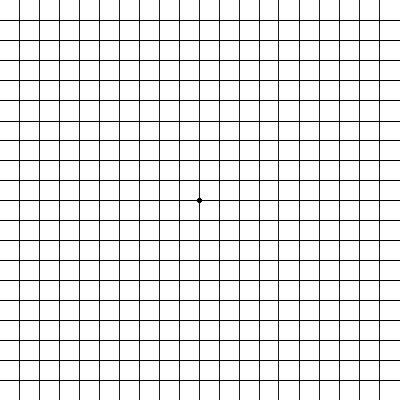KNOW YOUR RISKS
It's important to be aware of your family's health history, as many eye-related problems can be genetic, and to lead and healthy and active lifestyle. Below are some of the factors that can contribute to the development of AMD:
-
Genetics (family history)
-
Smoking (increases your risk significantly, so give it up)
-
High blood pressure (watch your lifestyle)
-
Exposure to UV light (especially after cataract surgery)
Monitor your eyes and be aware of any changes to your vision. Ask your optometrists to give you an Amsler Grid (see below). Regularly checking each eye, in turn, using this handy little card, can help detect early signs of changes in your central vision
THERE ARE 2 FORMS OF AGE-RELATED MACULAR DEGENERATION
1. DRY AMD
Dry AMD causes the central vision to become dimmer and as the disease progresses, the central vision can become distorted. Dry AMD is the most common form of AMD and affects about 90% of people who have AMD. As we age, the cells of the macula at the back of the eye become thinner and less efficient and they lose Lutein, an important pigment essential to good eye-sight. AMD is an acceleration of the natural aging process at the back of the eye.
Dry AMD cannot be treated, but taking Lutein supplements, following a healthy diet and lifestyle, with plenty of exercise and using good UV protective sunglasses can stabilise the progression of the condition.
2. WET AMD
This is where blood vessels behind the retina at the back of the eye, leak, causing central vision loss (think of leaky pipes behind a wall!). This causes a drop in oxygen supply to the cells in the macula and the body responds by producing new fragile blood vessels and scar tissue. This process will cause permanent vision loss to the central visual field.
Unlike dry AMD, wet AMD causes rapid vision loss and requires treatment. Wet AMD is thought to have a strong genetic link, so if a family member has had wet AMD it is wise to take a good Lutein supplement, follow a healthy diet and get plenty of exercise. You don't develop Wet AMD suddenly. You will have had Dry AMD, though you may not have been aware of it.
CHECK YOURSELF:
THE AMSLER GRID
The Amsler Grid may be helpful in revealing signs of wet Age-related Macular Degeneration (AMD). It is not a subsititute for regular eye tests.
Directions:
-
If you wear glasses or contact lenses for reading, put them on but do not wear varifocals or distance glasses
-
Stay at approximately 12 inches (30 cm) from the screen in front of your eyes, or you may print it and hold it directly in front of your eyes in a well lit room
-
Cover one eye with your hand and focus on the centre dot with your uncovered eye. Repeat with your other eye
-
If you see wavy, broken or distorted lines, blurred or missing areas of the vision, you may be displaying symptoms of AMD and should contact your Optician within the week.

